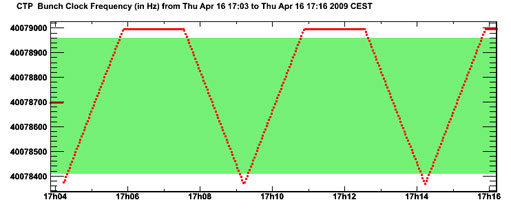
ATLAS e-News
23 February 2011
Keeping Time
29 June 2009

This plot shows the frequencies generated for one of the tests, in Hertz over time. The green band corresponds to the heavy ion frequency range, the largest we would ever experience, though the tests went beyond even this range. This test increased and decreased frequencies linearly over five minutes, but in the LHC, the frequency will rise smoothly over twenty minutes.
Timing is everything for ATLAS. During beam, proton bunches will whizz through the detector at a frequency of 40 Megahertz, providing a potential for collisions every 25 nanoseconds. But if ATLAS is going to take useful data, every subsystem needs to be ready to take digital “pictures” of the events at the exact same moment. In other words – they need to synchronise watches.
The watches, in this case, are “clocks” that run at 40 Megahertz inside each sub-detector, and will run in phase with the incoming proton bunches during beam. They will take their cues from the LHC’s clock at Point 4, where radio-frequency cavities capture and accelerate the proton beams.
Thilo Pauly has been taking advantage of the stable stretches during the last few weeks of detector commissioning. He has been tweaking ATLAS’s master clock to test the tolerance of the various subsystems to the kind of clock manipulations that are expected during beam, and uses the analogy of a clock shop – “Since we’re in Geneva,” he smiles – to explain the reasoning behind the tests. He compares the sub-detectors, running with their own internal clocks, to a shop stuffed full of clocks: They (theoretically) all require the same length of time for the hour hand to move on by one increment, but they don’t all read the same time, and will each chime randomly throughout the hour.
In contrast to this, ATLAS’s clocks are all synchronised. They are disciplined by a clock signal that comes constantly from Point 4 and is distributed to the sub-detectors via the Level1 Central Trigger Processor. In the analogy, this would manifest itself as a shop full of radio-controlled clocks, which all strike the hour – and the same hour – at exactly the same time.
Problems arise, however, because the ‘bunch clock’ at Point 4 is not constant; its frequency will track the slight increase in speed of the protons during the acceleration period, the phase will be altered slowly to facilitate bunch collisions right in the centre of the detector, and there are certain operational activities which are expected to cause the clock to disappear altogether for a fraction of a second. Additionally, it may sometimes be necessary to switch from the external LHC clock to the local ATLAS master clock, an action that could also cause problems.
Thilo’s task is to push the boundaries of ATLAS’s clock system, to investigate what effects these fluctuations might have on data-taking. Just as different radio-clocks respond slightly differently to changes in, or momentary loss of, the radio-controller frequency, so too might the numerous sub-detectors of ATLAS respond differently to a changing LHC clock signal.
Using a frequency generator – a small piece of kit connected to the electronics in the Counting Room – one sub-detector at a time is being tested against simulated LHC clock manipulations, to see what errors occur and how they show up in the ATLAS control room.
“We start with a stable run at high rate and then manipulate the clock stronger and stronger until we see the first errors,” explains Thilo. “We sweep through the whole expected frequency range, we switch between different clocks with slightly different frequencies, we move the phase slowly, and we take away the clock for a fraction of a second.”
The worst thing that can happen is for a sub-detector to lose its ‘lock to the clock’. “At some point, they can just give up and say, ‘At this frequency, I can’t behave!’,” explains Thilo. “Then all Hell breaks loose.” If this happens, the sub-detector often issues a busy signal and no data can be taken. The run is forced to stop, and everything must be re-configured before it can start again – a frustrating and time-consuming operation.
Some sub-detectors have proved a little more sensitive than others in the testing, “but so far there has been no disaster. There are no show stoppers!” reassures Thilo. For those cases where sub-detectors do lose their lock to the clock, fast recovery procedures are being worked on and will be put into place in the near future.
Meanwhile, the testing work will continue amid discussion and collaboration with the other experiments and the LHC. The plan is that, in a few months’ time, a test run will take place where the clock is manipulated directly from Point 4, just as it will be for beam.
Right now, the reactions of the detector are simply being logged. “We’re trying to ‘break’ the system, to see what happens,” says Thilo. “Based on the outcome of the tests, we will define in Run Coordination ATLAS's procedure to handle these clock manipulations in order to efficiently take good and meaningful data with the LHC.”

Ceri PerkinsATLAS e-News
|